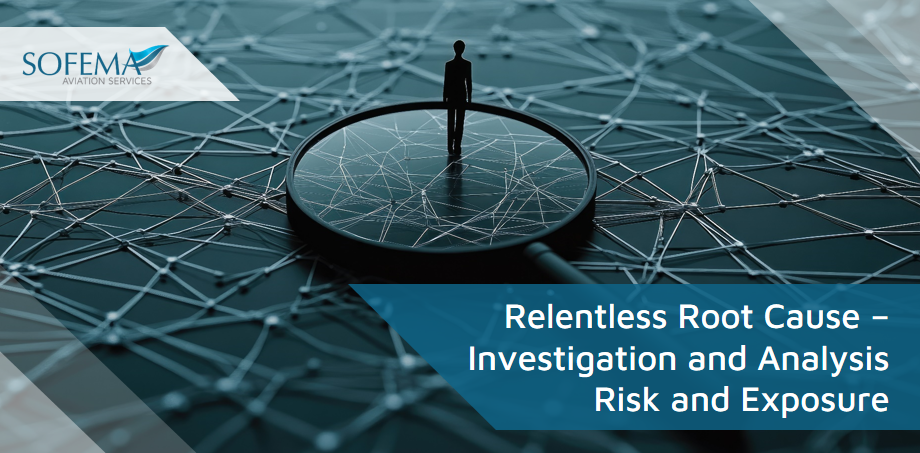Sofema Aviation Services (SAS) www.sassofia.com considers the relationship between relentless root cause and its importance in risk management and problem-solving.
Introduction
The relentless pursuit of root causes not only enhances safety and operational integrity but also aligns with strategic business objectives by mitigating risks and strengthening organizational resilience. By adopting structured analytical methodologies and fostering a supportive culture, organizations can effectively manage risks, minimize exposures, and enhance their overall safety protocols.
The process of investigation and analysis leading to the identification of root causes and contributing factors, followed by a comprehensive evaluation of risks and exposures, lays a solid foundation for developing robust safety protocols and preventive measures.
- Investigation involves systematically examining an incident to determine what happened.
- The process typically includes collecting evidence, interviewing witnesses, and reconstructing the sequence of events leading to the incident.
o The goal is to gather as much information as possible to provide a clear picture of the situation.
- Analysis considers the collected data which is scrutinized to identify why the incident happened.
o This is where root cause analysis (RCA) techniques are applied. RCA aims to identify the underlying problems that go beyond the immediate causes of the incident. It looks for systems failures, procedural errors, and deeper organizational issues.
- These techniques help uncover deeper systemic failures, procedural errors, and organizational issues that go beyond surface-level causes.
Investigation and Analysis Challenges:
- Identifying all contributing factors to failures or problems, especially when they are hidden or non-intuitive.
- Ensuring comprehensive data collection and avoiding bias in data interpretation.
- Time and resource constraints may pressure teams to seek quick fixes rather than true root causes.
Best Practices:
- Utilize structured methodologies like the “5 Whys” or “Fishbone Diagram” to guide the investigation.
- Foster a culture that values thorough analysis over quick fixes.
- Implement continuous training on analytical tools and techniques.
- Conduct risk assessments at each stage of the root cause analysis to understand potential fallout.
- Develop a strategic communication plan to manage information dissemination to stakeholders and the public.
- Integrate root cause analysis findings into the organization’s risk management framework.
- Maintain transparency in reporting methods and findings to build trust and support for necessary changes.
- Link the outcomes of root cause analyses to business objectives to highlight the value of implementing changes.
Additional Guidance:
- Encourage cross-functional team involvement to bring diverse perspectives into the analysis.
- Balancing the need for thorough root cause analysis with the potential for increased exposure to risks during the investigation phase.
Risk and Exposure Considerations
After identifying the root cause and contributing factors, an organization must assess the associated risks and exposures. This involves understanding the potential for future incidents and the impact they could have on the organization, its people, or the environment.
Exposure Analysis refers to evaluating the extent to which the organization is exposed to identified risks. It includes reviewing how well existing controls are working and where there might be vulnerabilities in the system.
With a thorough understanding of risks and exposures, organizations can develop mitigations consisting of:
- Preventive Actions are taken to remove or reduce the identified risks before an incident occurs, such as changing procedures, improving equipment, or enhancing training programs.
- Corrective Actions which aim to correct or mitigate the effects of the incident to prevent recurrence.
- Regularly reviewing safety measures and risk assessments to ensure they remain effective and make adjustments as necessary based on new findings or changes in the organization or its environment.
Conclusion
The “Relentless Root Cause” approach in risk management and problem-solving emphasizes a thorough and deep exploration of the underlying causes of incidents within an organization. This method involves a systematic sequence of investigation and analysis aimed at unveiling not just what happened during an incident but, more critically, why it happened. This approach ensures that all contributing factors—be they immediate or deep-seated within the organizational processes—are identified and addressed.
Next Step
Follow this link to our Library to find & download related documents for Free.
For guidance on available courses, please see Sofema Aviation Services and Sofema Online or email team@sassofia.com.
Tags:
Safety Compliance, Exposure Analysis, Corrective Actions, Preventive Actions, Systemic Failures, Investigation Techniques, Organizational Resilience, safety protocols, continuous improvement, aviation safety, Risk Mitigation, Operational Safety, SAS blogs, Safety Culture, Root Cause Analysis, Risk Management, Risk Assessment





